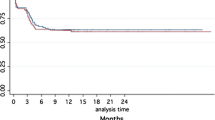Summary
The purpose of this study was to determine postoperative pain following inguinal herniorrhaphy dependent of technical factors such as: minimal access surgery, open transinguinal and preperitoneal tension-free repair, reduced suture line tension, type of anesthesia. 240 consecutive unilateral groin hernia repairs were prospectively allocated to one of five groups: Lichtenstein patch under local anesthesia, and the following under general anesthesia, Lichtenstein patch, laparoscopic TAPP repair, a modified Shouldice technique with omission of the third and fourth row of sutures and open preperitoneal prosthethic repair [Wantz 1989]. Using a visual pain analogue score, no significant differences were found for pain intensity between the groups on days 0, 1, 2, 3, 21. There was also no significant difference for return to work. Analgesic requirements were lower than in previous studies and this is attributed to immediate resumption of physical activity on a home-trainer bicycle. The percentage of patients who did not require any pain medication after the first postoperative day was 85% for Wantz, 81% for Shouldice, 86% for TAPP, 77% for Lichtenstein under general anesthesia and 89% for Lichtenstein under local anesthesia. Local anesthesia was the only technical factor for significantly reducing analgesic requirements during the three perioperative days. With local anesthesia and immediate resumption of physical activity early postoperative pain becomes a limited outcome measure for comparing open versus laparoscopic groin hernia repair techniques.
Similar content being viewed by others
References
Behnia R, Hashemi F, Stryker SJ, Ujiki GT, Poticha SM (1992) A comparison of general versus local anesthesia during inguinal herniorrhaphy. Surg Gynecol Obstet 174: 277–280
Brooks DC (1994) A prospective comparison of laparoscopic and tension-free open herniorrhaphy. Arch Surg 129: 361–366
Filipi CJ, Gaston-Johansson F, McBride PJ, Murayama K, Gerhardt J, Cornet DA, Lund RJ, Hirai D, Graham R, Patil K, Fitzgibbons JrR, Gaines RD (1996) An assessment of pain and return to normal activity. Laparoscopic herniorrhaphy vs. open tension-free Lichtenstein repair. Surg Endosc 10: 983–986
Hilgenberg JB (1986) Inhalation and intravenous drugs in the elderly patient. Seminars in Anesthesia 5: 44–54
Horeyseck G, Roland F, Rolfes N (1996) Tensionfree inguinal hernia repair: laparoscopic (TAPP) vs open (Lichtenstein). Chirurg 67: 1036–1040
Kux M, Fuchsjäger N, Schemper M (1994a) Shouldice is superior to Bassini inguinal herniorrhaphy. Am J Surg 168: 15–18
Kux M, Fuchsjäger N, Feichter A (1994b) Lichtenstein patch versus Shouldice technique for primary inguinal hernias at high risk of recurrence. Chirurg 65: 59–62
Leibl B, Däubler P, Schwarz J, Ulrich M, Bittner R (1995) Standardised laparoscopic hernioplasty vs. Shouldice repair. Results of a randomised comparative study. Chirurg 66:895–898
Liem MSL, van der Graaf Y, van Steensel CJ, Boelhouwer RU, Clevers GJ, Meijer WS, Stassen LPS, Vente JP, Weidema WF, Schrijvers AJP, van Vroonhoven TJMV (1997) Comparison of conventional anterior surgery and laparoscopic surgery for inguinal hernia repair. N Engl J Med 336:1541–1547
Payne HJ, Grininger LM, Izawa MT, Podoll EF, Lindahl PJ, Balfour J (1994) Laparoscopic or open inguinal herniorrhaphy? A randomized prospective trial. Arch Surg 129: 973
Salcedo-Wasicek MC, Thirlby RC (1995) Postoperative course after inguinal herniorrhaphy. A case-controlled comparison of patients receiving workers' compensation vs patients with commercial insurance. Arch Surg 130:29–32
Steffen P, Seeling W, Kunz R, Schuhmacher I, Georgieff, M (1997) Postoperative analgesia after endoscopic abdominal surgery. A randomized study for evaluation of the analgesic affect of dipyrone. Chirurg 68: 806–810
Stoker DL, Spiegelhalter DJ, Singh R, Wellwood JM (1994) Laparoscopic versus open inguinal hernia repair: randomized prospective trial. Lancet 343: 1243–1245
Tschudi J, Wagner M, Klaiber Ch, Brugger JJ, Frei E, Krähernbühl L, Inderbitzi R, Hüsler J (1996) Controlled multicenter trial laparoscopic transabdominal preperitoneal hernioplasty vs Shouldice herniorrhaphy: preliminary results. Surg Endosc 10: 845–855
Tverskoy M, Cozacov C, Ayache M, Bradley EL, Kissin I (1990) Postoperative pain after inguinal herniorrhaphy with different types of anesthesia. Anesth Analg 70: 29–35
Vogt DM, Curet MJ, Pitcher DE, Martin DT, Zucker KA (1995) Preliminary results of a prospective randomized trial of laparoscocpic onlay versus conventional inguinal herniorrhaphy. Am J Surg 169: 84–90
Wantz GE (1989) Giant prosthetic reinforcement of the visceral sac for the management of hernias of the groin at high risk for recurrence. Surg Gynecol Obstet 169: 408–412
Wilson Ms, Deans GT, Brough WA (1995) Prospective trial comparing Lichtenstein with laparoscopic tension-free mesh repair of inguinal hernia. Br J Surg 82: 274–277
Woolf CJ (1983) Evidence for a central component of post-injury pain hypersensitivity. Nature 306: 686–688
Zieren J, Zieren HU, Wenger FA, Müller JM. (1996) Laparoscopic or conventional inguinal hernia repair with mesh. Langenbecks Arch Chir 381: 289–294
Author information
Authors and Affiliations
Rights and permissions
About this article
Cite this article
Kawji, R., Feichter, A., Fuchsjäger, N. et al. Postoperative pain and return to activity after five different types of inguinal herniorrhaphy. Hernia 3, 31–35 (1999). https://doi.org/10.1007/BF01576739
Received:
Accepted:
Issue Date:
DOI: https://doi.org/10.1007/BF01576739




